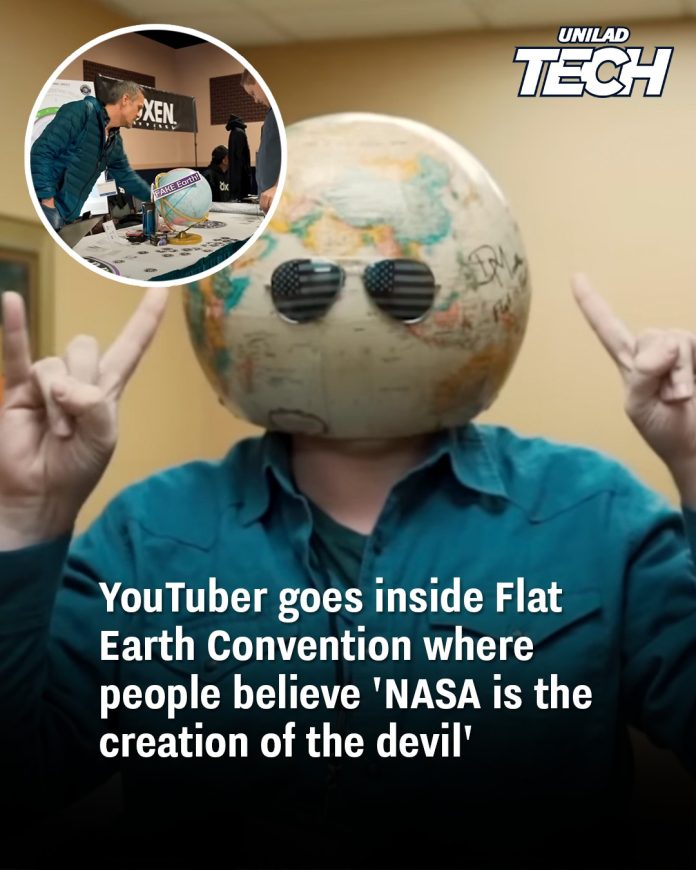In August 2024, YouTuber Dylan Dubeau ventured into the heart of a Flat Earth convention to explore the beliefs and assertions of its attendees. Documenting his experience on his channel, Not Exactly Normal, Dubeau provided an in-depth look into a community that challenges the widely accepted understanding of our planet’s shape and the credibility of space agencies like NASA.
A Resurgence of Ancient Beliefs
Historically, many ancient cultures subscribed to the notion of a flat Earth, a belief that persisted until scientific advancements provided evidence of our planet’s sphericity. Greek philosopher Plato discussed a spherical Earth as early as the fourth century BC. Despite centuries of scientific validation supporting a round Earth, there has been a contemporary resurgence of the Flat Earth theory. This modern movement has evolved into a comprehensive conspiracy theory, with adherents questioning the authenticity of space exploration and the motives of organizations like NASA.

Inside the Flat Earth Convention
Dubeau’s journey into the convention revealed a group deeply committed to skepticism and the reevaluation of established scientific narratives. He observed that the Flat Earth movement emphasizes questioning conventional teachings and encourages individuals to seek their own understanding of the world. However, this skepticism often leads to the outright dismissal of widely accepted scientific evidence.
One of the central tenets among Flat Earthers is the belief that NASA and other space agencies are engaged in a massive deception. Many attendees argued that space exploration is a fabrication designed to mislead the public. Speakers at the convention, such as Rick Hummer and Robbie Davidson, articulated views suggesting that the atmosphere is enclosed within a dome and that celestial bodies are merely points of light beyond this enclosure. They posited that NASA employees are complicit in disseminating false information, alleging that space missions are staged using underwater filming and green screen technology to create the illusion of space travel.
The Flat Earth Model
The convention showcased an alternative representation of the world, markedly different from the conventional globe model. In this Flat Earth paradigm, the Earth is depicted as a flat plane with the North Pole at its center and Antarctica forming a surrounding ice wall. This model suggests that the sun and moon are smaller than traditionally believed and move in concentric circles above the Earth, illuminating different areas in a manner akin to a spotlight. Such interpretations directly challenge the heliocentric model of the solar system, which positions the Earth as a sphere orbiting the sun.
Conspiracy Theories and Distrust
A pervasive theme at the convention was a profound distrust of mainstream scientific institutions and a belief in overarching conspiracies. Attendees expressed views that NASA was established by nefarious groups, including Nazis, Freemasons, and Scientologists, with the purported aim of promoting a false narrative about the cosmos and undermining religious beliefs. This perspective fosters a worldview where space is deemed nonexistent, and satellites are believed to be suspended from balloons rather than orbiting the Earth.
Public Reaction and Criticism
Dubeau’s documentation of the convention elicited a range of reactions from viewers. Many expressed skepticism and criticism toward the Flat Earth movement, highlighting the selective use of evidence to support preconceived conclusions. Comments from viewers underscored the importance of adhering to the scientific method, which involves forming conclusions based on evidence rather than seeking evidence to validate predetermined beliefs. Some viewers humorously remarked on the intellectual environment of the convention, suggesting that attending such an event could make one feel exceptionally knowledgeable by comparison.
The Broader Implications
The persistence and resurgence of the Flat Earth theory highlight broader issues related to scientific literacy, the dissemination of misinformation, and the psychological factors that contribute to the acceptance of conspiracy theories. Despite overwhelming empirical evidence supporting the Earth’s sphericity—from satellite imagery to circumnavigation—the Flat Earth movement exemplifies how deeply held beliefs can lead individuals to reject established facts.

Psychologists suggest that the appeal of such theories may stem from a desire for uniqueness, a distrust of authority, or the need to make sense of a complex and often chaotic world. The internet and social media platforms have further facilitated the spread of these ideas, allowing like-minded individuals to connect and reinforce their beliefs, often in echo chambers insulated from contradictory information.
Conclusion
Dylan Dubeau’s exploration of the Flat Earth convention offers a revealing glimpse into a community that challenges mainstream scientific consensus and promotes alternative interpretations of our world. While the Flat Earth theory lacks empirical support and is contradicted by centuries of scientific research, its persistence underscores the need for continued efforts in science education and critical thinking. Engaging with and understanding the motivations behind such beliefs can provide valuable insights into the complexities of human cognition and the societal factors that influence the acceptance or rejection of scientific knowledge.

















